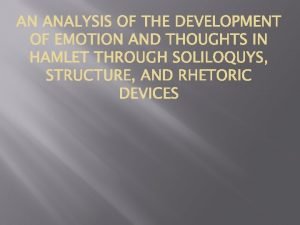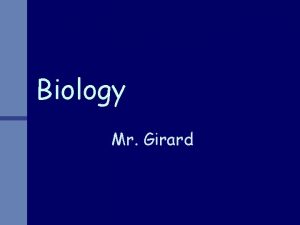HAMLETS DULL REVENGE 1 Girard explains that Shakespeare





- Slides: 5

HAMLET’S DULL REVENGE 1. Girard explains that Shakespeare had dual motives in writing Hamlet: to achieve a dramatic success with a play about revenge, while also making the point that revenge theatre was flawed (lines 15 -20). 2. Girard argues that Hamlet is not fully convinced that Claudius deserves to die, since the victim, his father, may not have been completely blameless. In that case, carrying out revenge would make Hamlet as guilty as Claudius. Girard says that Hamlet’s feelings about revenge illustrate what Shakespeare felt about revenge theatre – he no longer believed in it. 3. The central idea developed in lines 25 -70 is that Shakespeare’s play shows how he understood the problems of revenge theatre and revenge itself (lines 29 -35).

HAMLET’S DULL REVENGE 4. Girard adopts an admiring tone toward Shakespeare for creating a complex and successful play in a genre he no longer believed in. His rationale for scenes that might not otherwise make sense, his direct statements about Shakespeare’s skill, and his choice of words and phrases help to reveal his attitude. 5. He cites the actor (line 81), the army (line 99), and Laertes (line 123) as “mimetic incitements” for Hamlet. Their sequential presentation, building to the strongest, provides increasing support for his claim. 6. Girard implies that Shakespeare uses Laertes to represent or personify revenge theatre. He calls Laertes a “formalist, ” one who observes the outward forms of revenge without questioning the validity of the act, the genre, or the relationship between revenge and mourning. Laertes’ character enables Shakespeare to pose such questions.

HAMLET’S DULL REVENGE 7. The quotations show each model is a catalyst for Hamlet’s introspection and eventual change of heart. 8. Girard claims that by resisting the social impetus that demands revenge and perpetuates violence, Hamlet reveals Shakespeare’s own revulsion toward revenge theatre. He cites examples of models that represent how all remain trapped in an inescapable cycle. 9. “The birth of something portentous” or awe-inspiring is both Hamlet’s decision to act and Shakespeare’s play itself, which excites wonder and awe at his artistry.

HAMLET’S DULL REVENGE WRITTEN RESPONSE • In at least ½ a page, respond to the following as a group (you may use the same paper you wrote your questions on, if you have room): • Does Girard succeed in presenting a valid interpretation of Hamlet? • Identify Girard’s claim, reasons and evidence, then summarize his interpretation. • Thoroughly explain your reasoning and use details from the essay to back it up. • Do you agree or disagree with Girard’s interpretation? Explain, using evidence from the essay and the play to support your response (paraphrasing is ok).

UNIT TEST OVERVIEW • • Hamlet Close Reading Informational Text Figurative Language (in Hamlet) Revising and Editing/Grammar • Subordinate Clause • Combining Sentences • Spelling • Vocab. In Context









